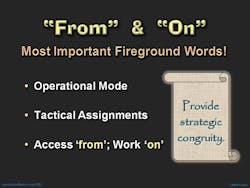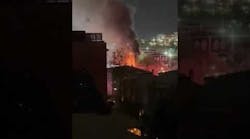Part two (July 2011) discussed how to achieve and maintain tactical accountability using simple strategic tools and processes that can eliminate freelancing and make tactical accountability work. Part three will:
1. Introduce the three levels of fireground freelancing.
2. Describe how to eliminate functional freelancing.
3. Describe how to eliminate geographic freelancing.
4. Teach how to capture and account for volunteer firefighters.
5. Clarify the true difference between a division and a group.
If you are just joining the series, what follows is a brief overview of tactical accountability. For those of you who have read parts one and two, additional information clarifies and reinforces the principles of Integrated Tactical Accountability (ITAC).
Tactical Accountability Review
Tactical accountability is a strategic benchmark that is achieved and maintained throughout an incident. A benefit of tactical accountability is that nobody is allowed, or needs, to freelance. Achieving tactical accountability means somebody at a strategic level knows who they are responsible for, where they are and what they are doing at all times; nobody slips “through the cracks.”
The process, or system, for achieving and maintaining tactical accountability is called Integrated Tactical Accountability. The word “integrated” was chosen because ITAC brings together each element of contemporary incident management into one implementation “system.” These integrated elements are the National Incident Management System (NIMS), National Fire Protection Association (NFPA), Incident Command System (ICS), Occupational Safety and Health Administration (OSHA) and passport accountability (Figure 1). Each element advises what you should do, but does not provide a comprehensive template for compliance or implementation. ITAC offers methods and techniques that unify the guidance these groups and documents offer into a single, integrated implementation system.
For example, this seamless integration means that, in the context of ITAC, you cannot talk about a division without including:
· How a division supervisor achieves and maintains tactical accountability
· How and in what form does a division supervisor receive their piece of the overall action plan
· How a division supervisor conveys a division status report
· How a division supervisor obtains additional teams
· How a division supervisor withdraws all assigned teams in an calm and orderly fashion
· How a division supervisor coordinates a roll call
Each bullet describes how a division supervisor supervises, which ventures well beyond knowing that a division is “geographic.” ITAC does not compete with or replace NIMS or ICS. Think of ITAC in this context: ITAC is to NIMS ICS what Microsoft Windows is to the robust MS DOS computer operating system; Windows provides an implementation interface that makes MS DOS intuitive, user friendly and easy to use (Figure 2.) In short, ITAC provides an integrated implementation interface for NIMS, ICS, NFPA and OSHA.
ITAC targets four strategic components that are essential for an incident to be managed competently; these four components are so crucial that they form the core of the Integrated Tactical Accountability methodology (and thus the acronym ITAC):
· Incident command that is competent
· Tactical accountability of all personnel at all times
· Action planning that is quick and easy
· Communications that are clear, concise and disciplined
Ignore (or botch) any one of these core strategic components and the after-action review will not go well. In fact, if you want to determine the strategic competence of an incident, simply ask four questions during the after-action review:
1. Was command competent? (A negative response means the next three will not go well.)
2. Was everybody tactically accounted for at all times?
3. Was there an overall incident action plan (IAP) and did everybody know what piece of the plan they owned?
4. Were radio communications clear, concise and disciplined?
Imagine you were the incident commander during a two-alarm building fire. Those four questions are asked during the after-action review and evidence (good or bad) was required to substantiate each judgment. If you received thumbs-up for each question – supported with documented positive evidence – what else could you ask for? (Assuming it was a round trip for everybody back to the fire station.) Any negative feedback or observations would be used to fine-tune with training. (Important note: It will never be perfect; perfect doesn’t exist. However, with ongoing training, it is possible to reduce imperfection.)
The purpose of ITAC (or ICS) is not to host a pageant of fire officers modeling colorful vests; rather, ITAC can help ensure that you achieve an appropriate balance of strategic-level stuff with tactical-level stuff. That said, you must admit that botched tactics is probably not listed among the top three problems encountered during your fireground operations. That is because good tactics (firefighter stuff) is pretty easy compared to good strategy (fire officer stuff). When was the last time you read a NIMS fatality investigation that identified bungled tactics as a contributing factor? Aggressive strategy is not easy; ITAC provides a template for executing aggressive strategy.
Three Levels of Freelancing
There are three levels of freelancing that feed off each other:
1. Strategic
2. Tactical
3. Task
Strategic-level freelancing enables tactical-level freelancing; tactical-level freelancing enables task-level freelancing. As this cycle of freelancing perpetuates, often for decades, the risk continues to ratchet up and the tension builds.
Perhaps the common image of freelancing is associated with a firefighter at task level. Visualize a firefighter wandering the fireground clutching a tool. The firefighter passes a window and notices smoke swirling slowly on the interior side of the glass. The firefighter looks around, hoists the tool and breaks the glass. Often, this is done with firefighters operating inside the building. Horizontal ventilation makes a fire grow, more so than vertical ventilation. That said, the combination of horizontal and vertical ventilation will generate the most vigorous fire conditions. (Think of a wood-burning stove; place the fuel and the heat between a wide-open damper and a wide-open flue and you have the perfect conditions for an impressive compartment fire. For more information, review my September 2008 Firehouse® article “Grading the Fireground on the ‘Curve.’ ”)
Tactical freelancing is the domain of company officers and team leaders. Visualize an engine company crew looking around for something to do. The team leader observes something shiny in the distance and off the team goes. Another example is a company officer that does not keep the team together. Visualize a solo company officer engaged in self-directed task-level recreation and has no idea where the team’s firefighters are or what they are doing.
Strategic freelancing occurs at the division/group supervisor level. An example of strategic freelancing is an incident commander making this radio announcement: “Battalion 2, on your arrival establish Division Charlie.” Battalion 2 parks on side C, looks around, formulates a side-C action plan and begins making assignments to nearby firefighters who don’t look busy. This is not how the system is supposed to work.
Battalion 2 looking around and developing the side-C action plan is strategic-level freelancing. Better for the incident commander to wait for Battalion 2 to report to the command post and provide the side-C portion of the incident commander’s overall action plan.
Ultimately, all levels of freelancing are enabled by a fourth level: Command freelancing. Command freelancing is easy to identify: visualize a chief officer wandering the fireground with a portable radio. No strategic tools, not managing from a command post. This migrating “incident commander” often serves as the gatekeeper of tactical- and task-level freelancing: “Hey Chief, can we (fill in the blank with a favorite task using a favorite tool)?” The chief replies, “Yeah, that’s a great idea. Be safe!” Such antics are evidence that the so-called incident commander:
1. Has not done size-up.
2. Does not have an action plan.
3. Has not declared the operational mode.
4. Is not managing span of control.
5. Is not coordinating objectives.
6. Has not achieved and is not maintaining tactical accountability.
Command-level freelancing begets strategic-level freelancing; strategic-level freelancing begets tactical-level freelancing; and tactical-level freelancing begets task-level freelancing.
How to Eliminate Geographic Freelancing
The “Command Caveat” for eliminating geographic freelancing is: Never assign something to do without someplace to do it. An assignment that enables geographic freelancing sounds something like this: “Truck 31 primary search.” This assignment is a green light for Truck 31 to freelance geographically; if Truck 31 is going to decide where to enter and where to search, the company is freelancing geographically. Geographic freelancing can be strategic, tactical or task level; geographic freelancing means tactical accountability is not being maintained and likely has not been achieved.
By assigning a company or team an objective, an access location and a work location, tactical accountability will be achieved by the who-what-where nature of the assignment. This can be done by incorporating the words “from” and “on” into all tactical assignments (Figure 3). Returning to the Truck 31 example, it would sound like this: “Truck 31, primary search from side A on floor 2.” (Who is Truck 31? What is primary search? Where is "from side A on floor 2"?)
How to Eliminate Functional Freelancing
The “Command Caveat” for eliminating functional freelancing is: Never send somebody someplace without something to do when they get there. A strategic-level example is the previously mentioned Battalion 2 that was directed to “on your arrival establish Division C.” A tactical example would be to convey an assignment without a work location: “Engine 35, on your arrival you’ll be interior.” Interior what? Interior division? Confine and extinguish? Primary search? Make coffee? The likely scenario is that Engine 35 will park, grab favorite tools, enter the building, scan the interior, see something shiny through the smoke haze and off they go. If a resource will decide what to do, they will be freelancing functionally; functional freelancing can be strategic, tactical or task level.
Another example of functional freelancing is an “assignment” I heard on the fireground a few years ago (apparatus designators have been changed to protect the guilty): “Truck XX, go up to floor 2 and see if there’s something you can do to help Engine XX.” That “assignment” was a free pass for Truck XX to freelance functionally.
When Truck XX does find something to do, you will have no idea where they are or what they are doing. If Engine XX didn’t need assistance, did Truck XX ascend to floor 3? Are they are at staging sipping Gatorade? Of course, Truck XX could call you on the radio and let you know where they are and what they are doing, but that generates a few problems: you don’t have their passport, it generates extra radio traffic and makes you a gatekeeper of freelancing. The bottom line is that Truck XX will likely be freelancing both geographically and functionally.
Divisions and Groups: The ITAC Difference
For decades, the ICS distinction between a division and a group has been that “divisions are geographic” and “groups are functional.” Although nice and tidy, these definitions conjure two questions:
1. Should teams assigned to a division do something functional?
2. Should teams assigned to a group do their function someplace geographic?
If the answer to both is affirmative, then what is the true difference between a division and a group? Consider these ITAC definitions:
1. A division is assigned multiple objectives that will be performed within the supervisor’s geographic area of responsibility. Division supervisors are designated geographically and report to an individual who has branch responsibility.
2 A group is assigned a single objective that will be performed within the supervisor’s geographic area of responsibility. Group supervisors are designated functionally and report to an individual who has branch responsibility.
These definitions are more accurate and more useful than the traditional model. Take a look at the two status boards shown below. Based on my definitions, you should be able to determine which is the division status board and which is the group status board.
In Figure 4, the group supervisor status board shows a single tactical objective – evacuation – and one support objective – rapid intervention – being performed from or at multiple geographic locations. In this case, the functional objective and the geographic work location for each team assigned to the group is shown using status board shorthand shown above.
Let’s say that the evacuation group supervisor is in stairwell B on floor 11. A team would be sent from staging to evacuation group as follows: “Squad 51, report to evacuation group, in stairwell Bravo, on floor 11.” After ascending stairwell B and arriving on floor 11, the team leader surrenders the Squad 51 passport to the evacuation group supervisor and their objective and work location are conveyed face to face. (In case you haven’t noticed, ITAC strives to reduce radio communications and encourages face-to-face communications.)
In Figure 5, the division supervisor status board shows multiple tactical and support objectives being performed from or at the supervisor’s geographic area of responsibility. In this case, each of the division’s functional objectives and geographic work locations are shown for each assigned team using status board shorthand at the lower left of this page.
If the division supervisor was on side A of the building (in this case, the front yard of a house), teams would be sent from staging to “Division Alpha.” Teams would surrender their passports to the supervisor, the passport would be plugged into the Division A action plan, and the team’s objective and work location conveyed face to face. The division status board even reveals the operational mode: Offensive from side A on floor 2.
The important thing to recognize on both boards is that after a quick look at either one, you quickly discern that tactical accountability has been achieved and is being maintained. The glance also reveals that the group supervisor needs one more team to complete the group’s piece of the incident commander’s overall action plan (a team to evacuate floor 15).
Accounting for Volunteer Firefighters
If volunteers respond to the fire station, accountability is simple and straightforward: passports are assembled in the fire station and on each apparatus. A passport and corresponding helmet shield should be maintained in the cab of each apparatus. As volunteers arrive, they mount an apparatus, place their name tags on the apparatus passport and place the apparatus helmet shields on their helmets. As the apparatus responds, the officer examines the passports and confirms that the name tag of each riding member is on the passport (Figure 6).
Should volunteers respond directly to the incident scene, the system is flexible and will adapt easily. Volunteers report to the command post or the staging area and hand their name tags to the incident commander or the staging area manager. Firefighter name tags are placed on “phantom team” passports. A phantom team is represented by a blue passport; a blue passport indicates there is no apparatus associated with the passport; thus, the team is phantom. Once sufficient personnel have been assembled (attached) on the phantom passport and a team leader has been designated, the team is ready to enter the game. (As with any passport, the top name tag indicates the team leader.) Blue helmet shields should be available that correspond with each phantom passport. Team members affix the phantom team helmet shields to their helmets.
Call to Action
For generations, the fire service has nurtured a proud history and tradition of aggressive tactics. The time has come to establish a proud history and tradition of aggressive strategy. My purpose for this series is to demonstrate that achieving and maintaining tactical accountability is important, possible and not difficult. My hope is that you will embrace these principles so that everybody truly does go home.
I’ll leave you with this thought: You are the incident commander four hours into a five-alarm fire. If your implementation system can’t tell you where “Engine 54” is and what those firefighters are doing, what exactly have you been managing using NIMS? A structured and systematic approach doesn’t include broadcasting on the radio: “Engine 54 from Main Street Command, where are you?”
Next: How to nail your first-due strategic responsibility.






